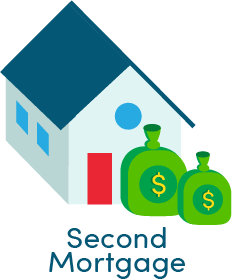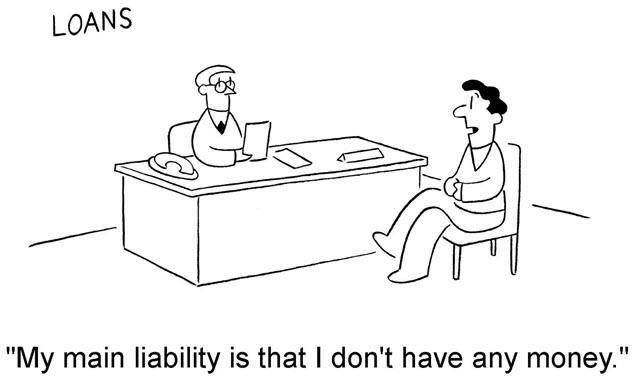How To Get A Second Mortgage
How do You Get a Second Mortgage?
 A second mortgage is quite simply a loan taken after the first mortgage. There can be various reasons to take out a second mortgage, such as consolidating debts, financing home improvements, or covering a portion of the down payment on the first mortgage to avoid the property mortgage insurance (PMI) requirement. The second mortgage, secured with the same assets as the first, usually carries a higher rate of interest than the first mortgage. The amount that can be borrowed is based on the equity in the home, which is the difference between the current value of the property and the amount that is owed on it. Another option, if there is enough equity, is to refinance and borrow funds in excess of the current loan balance.
A second mortgage is quite simply a loan taken after the first mortgage. There can be various reasons to take out a second mortgage, such as consolidating debts, financing home improvements, or covering a portion of the down payment on the first mortgage to avoid the property mortgage insurance (PMI) requirement. The second mortgage, secured with the same assets as the first, usually carries a higher rate of interest than the first mortgage. The amount that can be borrowed is based on the equity in the home, which is the difference between the current value of the property and the amount that is owed on it. Another option, if there is enough equity, is to refinance and borrow funds in excess of the current loan balance.
Loan Term
Second mortgage loans usually have terms of up to 20 years or as little as one year. The shorter the term of the loan, the higher the monthly payment will be. It is always a good idea to talk about the terms of repayment with the lending mortgage company to select the loan that will best suit the needs of the homeowner. For example, when borrowing $30,000 to make home repairs, it may not be a good idea to select a loan that would require repayment of the loan within one to 2 years because the payments each month could be too high to manage.
Most homeowners tend to select home equity lines of credit (HELOC) instead of home equity loans for their second mortgage needs, with HELOCs making up around 90% of the overall market volume. When market rates fall many homeowners choose to do a cash out refinance instead of obtaining a second mortgage.

Home Equity Lines of Credit (HELOC)
These act similarly to credit cards during the initial draw period where the borrower can pay them off and use them over again. After what is typically a 10 to 15 year draw period these convert to amortizing loans which must be repaid in full over the repayment period, which is typically 10 years. HELOCs typically do not have an application fee, though if you do not use the line they may charge an annual account maintenance fee of up to $100.
Home Equity Loans
These act similarly to first mortgages, though typically charge slightly higher interest rates as the first note holder is paid first in case of default. These charge a 3 to 5 percent closing cost Either form of a second mortgage can typically close within a couple weeks to a month.
Cash Out Refinancing
A cash out refinance is just like a regular mortgage refinance except you add to the amount borrowed to use the cash for other purposes. These typically charge 3 percent to 5 percent to close and take around a month and a half to two months to close.
Homeowners: Leverage Your Home Equity Today
Our rate table lists current home equity offers in your area, which you can use to find a local lender or compare against other loan options. From the [loan type] select box you can choose between HELOCs and home equity loans of a 5, 10, 15, 20 or 30 year duration.
Costs
All companies, including mortgage lenders charge a lending fee. Lenders typically charge loan origination fees and appraisal costs in addition to points. "Points" are a fee for lowering the interest rate of the loan. One percent that is borrowed is equal to one point. For example, a loan of twenty thousand that had a fee of 8 "points", the actual fee would be $1,600 in "points". The amount of points charged by a mortgage company can vary and it is a good idea to check with several lenders to get the best rate. Before agreeing to the loan, always get how much the fee is in writing. Some states limit the fee amount that a lender may charge on a second loan. The state banking commissioner or consumer protection office can provide information on any state limits. If there is a limit, compare it against any written quotes provided by the mortgage company.
Annual Percent Rates
If the loan has a fixed rate, which means that stays the same for entire term of the loan. However, there are quite a few lenders that will give borrowers variable rate mortgages. These are also known as adjustable rate mortgages. ARMs may have what is called a periodic interest rate adjustment over the life of the loan. If the contract lets the lender to change or adjust the rate of interest, it is important to know when the rate can be changed, how often it can be changed and even if there are limits as to what amounts the payments or interest can be changed. The mortgage company should also advise what basis will be used to figure a new interest rate.
Types
The common reasons people get a second mortgage are:
- to avoid paying PMI on their first mortgage
- consolidate other higher interest debts into a single lower interest payments
- creating a home equity line of credit (HELOC)
- home repairs & improvements

Should You Obtain a Second Mortgage or Pay PMI?
Compare your options: calculate your costs of paying PMI versus taking out a second mortgage.
There are two kinds of secondary mortgages: home equity loans (which usually charge fixed rates) & home equity lines of credit. The home equity line of credit is an adjustable rate mortgage. The rate of interest on this loan is fixed for a stated time period and then becomes an adjustable rate for the remainder of the loan. The adjustment, based on changes in a pre-selected index, is set on a pre-defined schedule, usually once a year. The interest rate and monthly payment "adjust" based on the index changes. The line of credit is similar to a credit card: there is a maximum limit. Over the life of the loan, any amount of money may be taken out up to the amount of the maximum limit. The entire amount may be paid off ahead of schedule, and the line may be kept open for future withdrawals. However, the line of credit does have a fixed life. There is a stated length of time to make withdrawals and to pay off the debt. Once the life of the loan is over, it would be necessary to either pay off the entire balance or refinance it.
Other Important Facts
The lender of the original home mortgage has precedence over the lender of the second mortgage.
The process for getting a second mortgage is the same process as getting a first mortgage. All of the financial paperwork and personal information must be completed, a new home appraisal is required and the new lender must have all the necessary information to determine if they will be able to finance the loan.
The second mortgage is a new loan and there are fees involved. There are loan origination fees, appraisal fees and closing costs as there were with the first mortgage.

The second mortgage may be harder to obtain. When a first mortgage is refinanced, the lender has the first lien on the property if there is a foreclosure or loan default. When the second mortgage is taken, the lender is aware that if the first mortgage is foreclosed on, they will be paid what is owed to them first and the remainder will be paid to the subsequent lenders.
When there is a second mortgage there are two payments every month instead of one. The first mortgage payment is made in addition to the second mortgage payment every month to avoid defaulting on the loans.
Homeowners May Want to Refinance While Rates Are Low
The Federal Reserve has hinted they are likely to taper their bond buying program later this year. Lock in today's low rates and save on your loan.
Are you paying too much for your mortgage?
Find Out What You Qualify For
Check your refinance options with a trusted local lender.
Answer a few questions below and connect with a lender who can help you refinance and save today!
How To Get A Second Mortgage
Source: https://www.mortgagecalculator.org/helpful-advice/second-mortgage.php
Posted by: vargasanich1974.blogspot.com

0 Response to "How To Get A Second Mortgage"
Post a Comment